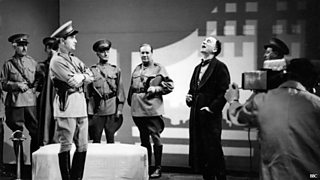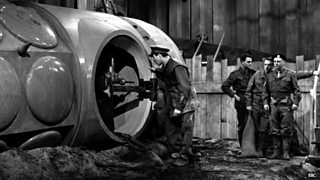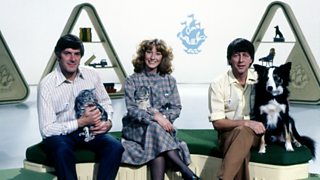
The 1938 Julius Caesar in modern dress, backgrounds courtesy of the versatile Penumbrascope.
One of the most important craft skills in television is that of the designer – now usually called the production designer.
He or she is responsible primarily for the sets of a programme (and ‘settings’ is how they are credited in many early programmes), but in a more general sense, for making the 'world' of a programme, whether fictional or factual, into something that can be realised in a studio or on location.
Television has been described - especially in its early, live, days - as a hybrid of radio, theatre and film. Its immediacy and reach was similar to radio; it had film’s property of presenting a story in pictures with the ability to cut from one image to another. It mirrored theatre in that only certain effects could be achieved physically because of limited space, and because the action had to be mounted continuously in real time, even if it was discontinuous in the play.
Increasingly sophisticated visual effects such as CGI and green-screen, have become a common element in many modern productions, enabling scenes that need impossibly large casts, sets, or fantastic landscapes to be realised. Though technicians are a vital part of creating such effects, they would not be effective without the skills of designers. Lighting and camerawork of course play a vital central role in realising the visuals of a programme, and cannot be ignored as part of the design equation – but that is a topic for another time...
The origins of television design
The very earliest television, low-definition broadcasts by the Baird company from 1929, had very limited design elements because of the nature of the technology. 30-line images were so poor that the constant problem was to create any kind of meaningful image, so anything other than a plain backcloth would probably have been more of a hindrance. Early television did however use a chequerboard pattern flooring which gave a basic sense of perspective.
A new world was opened up by high definition television in 1936. At first artists often performed in front of curtains, behind which successive acts could be in waiting, but soon the desire for more complex scenery arose, particularly for drama. Early scenery was crude, partly because even with a higher line standard, pictures were not very sharp, and still in black and white, they were seen at home on tiny screens. But there were was an increasing sophistication of design, with pioneers like Peter Bax responding to the rapid rise in the ambition and complexity of productions.
Plays like the modern dress Julius Caesar, , gangster drama Smoky Cell, or , showed the range of productions attempted. There were also shorter productions like the romantic comedy Ann and Harold and the series of ‘whodunnits’ called Telecrimes, the design for which made the most of limited resources. One of the more adventurous techniques was the ‘penumbrascope’, which used impressionistic shadows to create moods quickly and economically.

Quatermass and the Pit - the 10.38 to Mars is delayed due to the wrong kind of mud.
With the seven year hiatus caused by World War Two, television hardly developed until the 1950s, but there was a new influx of talent after the war, and increasingly sophisticated technology. Better cameras, the spread of television beyond London, and the beginnings of recording technology all added to the excitement around the medium. Design started to become more important, whether Hollywood-influenced variety settings, or increasingly realistic backdrops for dramas. With more programmes, designers had to be found from a range of disciplines, rather than just theatre design or cinema art direction.
The Quatermass Experience
The existing early recordings of programmes give us a chance to see how settings worked within programmes, rather than relying on still photographs for evidence as we have to do with earlier broadcasts.
One of the earliest existing shows is (designer Stewart Marshall), Nigel Kneale’s ground-breaking science fiction horror story from 1953. From the two surviving episodes it can be seen that ambitious sets like the wreckage of a house destroyed by a crashing rocket were possible. Later episodes featured the story’s climax in Westminster Abbey, which used a mixture of studio sets and photo blow-ups.
The following year Kneale adapted George Orwell’s (Barry Learoyd) in a memorable and historic version, which had highly effective design elements – from scene-setting paintings of ruined London, to the contrasting technological sheen of the Ministry of Truth and the shabby houses of the ‘proles’.
The Quatermass series are a useful way of studying the developments of television through the 50s, with series made in 1953, 1955 and 1958 demonstrating changes in acting style, production and design. The 1955 series (Stephen Taylor) already has a faster pace, and more ambitious sets, making the most of the space available at Lime Grove studios.
While some of its more memorable sequences are achieved using the increased amount of filming available, the studio sets show how effectively a story can be told by creating a series of different places that set contrasting scenes – from an Army radar truck, to laboratories and control rooms, cafes to committee rooms in the Houses of Parliament.
The final �������� Quatermass series, (Clifford Hatts), showed how programmes could be opened out even more. By this time the ��������’s own film studios at Ealing were fully functioning, and the main location, the ‘Pit’, an excavation site in London’s Knightsbridge containing a crashed Martian spaceship, was effectively realised both at Ealing and in the ��������’s Riverside Studios.

Three presenters, three pets, three-cornered shelving - the golden years of Blue Peter set design in 1977.
Television Centre meanwhile, as a purpose built programme factory, did make life easier for designers in realising their visions. With dedicated workshops for constructing and painting scenery, linked to the studios by access roads, many of the problems associated with other venues were overcome. There is a story that the original police box prop built for Doctor Who in 1963 had to be reduced in size because it could not be fitted into the scenery lift at Lime Grove, an idiosyncratic building at best.
Outside the sphere of drama and comedy, sets are still important to create the mood and house the action of shows from variety to politics and current affairs, chat shows to children’s factual programmes.
A Whole Scene Going
In these cases the design edict that form follows function is king: Blue Peter needed a large, empty studio to accommodate gymnastic displays, large vehicles, pop bands, and at Christmas, hordes of schoolchildren and the – but the presenters were usually to be found firstly on the iconic seating unit in the centre of the studio, the focal point of each episode.
In discussion shows, the designer needs to consider where to position the chairperson and the guests, and sometimes there is an audience too, as with . Likewise the modern proliferation of panel shows such as has seen their set designs become more inventive as while retaining a common layout of panellists and compere. Chat shows tend to have a more relaxed version of the same layout.

The instantly recognisable set for Have I Got News for You.
Another vital aspect of design is the technical one of where the camera and sound crews can be placed so they can actually record the programme. With audience shows, whether chat shows or sitcoms, the audience should be able to see the action going on, though inevitably some sequences will only be visible on studio monitors.
Oh in Colour
When colour made its entrance in the late 1960s, there needed to be a rethink on the part of all designers. Although it had been in development since the 50s, the technology turned out to be over-sensitive to certain shades, and it took much trial and error before realistic-looking colours were achieved. The start of ��������2 in 1964 had also meant recruiting extra design staff, and new ideas were imported along with them, which saw fruition in the brave new world of colour.
As years have gone on, other technological challenges have faced designers – from better cameras, subtler lighting, to widescreen and high definition, with the latter potentially only increasing in sharpness. The decline of film and its replacement with ‘filmised’ videotape production has no doubt also had subtle effects on design effort, although the ease with which videotaped images can be replayed makes life easier for the designer as well as the director in allowing them to quickly see how their work looks, and how it could be improved.
As long as television is made there will be a place for the designer. While many programmes can be made now in ‘real’ locations, there is still a certain amount of artifice needed for the particular needs of productions.
Much of television is still made in studio conditions, and it’s a rare programme that needs no setting at all, or just the minimal curtain that sufficed back in the early 1930s. Every show has its unique challenges, and in the final analysis it is the experience and skill of the designer that has to solve them.
What are your favourite iconic settings for programmes? Share your thoughts on the importance of television design in the box below...
